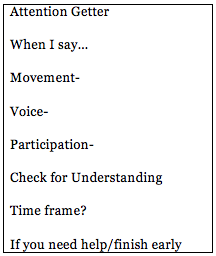“What looks like resistance, is often lack of clarity.” – Chip and Dan Heath
Carol Dweck’s (2012) concept of growth mindset is all the rage in education these days. In case you aren’t familiar with it, the concept of growth mindset starts with the educator holding the positive presupposition that everyone wants to and can learn. Growth mindset refers to the belief that:
One’s most basic abilities can be developed through dedication and hard work; brains and talent are just the starting point.
The above belief is in stark contrast to the notion of a fixed mindset, where the fundamental belief is that one’s qualities, intelligence, and talents are fixed traits.
The implications of the growth mindset belief in teaching and learning are powerful. But I often hear educators say, “What does the growth mindset look and sound like in practice?” Or they tell me, “I have a growth mindset, but the students don’t follow my directions.”
An idea that has been helpful for me in coaching teachers to understand growth mindset is a tenant offered in Switch, Chip and Dan Heath’s book about human motivation. They write, “What looks like resistance is often lack of clarity.” Ultimately in the classroom setting, the onus is on the teacher to provide clarity for students.
When Real Time Teacher Coaching® on the No-Nonsense Nurturer® (NNN) Four-Step Model, I often examine teacher’s directions with them and say, “Pretend you are (name of one of their students), are your directions as clear as they can possibly be?” If not, we spend time planning and role-playing the delivery of more precise directions. Then, during live instruction, I cue them to deliver the directions and note whether students are engaged in the task or not.
Imagine a 4th-grade writing lesson on the process of using evidence from informational texts to defend one’s claims. Look at the two different examples of directions. Which one promotes a growth mindset?
Directions #1: Ok students. Today, you will find evidence for the claim your group generated yesterday. Let’s get started.
Precise Directions #2: When I start the timer, you have 30 minutes in your groups to work at level 1 voices in your seats on finding three pieces of evidence for the claim your group generated yesterday. If you finish early, I challenge you to write a counterclaim and find evidence to support it. If you need help, send the messenger from your group to the back table. The timer is set for 30 minutes. What are we doing (call student)? What can we do if we are done or need help (call student)? The timer has started, go!
If growth mindset is the belief that qualities can change and we can develop our intelligence and abilities, then the second set of directions conveys that belief in a stronger way because the teacher has been clear with the students about how to persevere if they encounter struggle and set an expectation that they will challenge themselves further. The first example presumes there is one way to get the job done and those who have the abilities will do so. In the second set, the teacher has anticipated differing levels of proficiency with the task and made these options explicit, thereby providing an entry point and a reach for every student. The teacher then doesn’t have to spend time nagging and clarifying, instead, she can spend the majority of her time coaching students to try different approaches and giving students personalized academic feedback. These teacher moves build relationships and demonstrate even deeper levels of actualizing a growth mindset.
The power in teaching with a growth mindset ultimately involves a gradual release of responsibility so students can become more self-sufficient in their academic endeavors. When teacher directions are precise, the students have a better chance at becoming self-directed learners! Below is a template I use for crafting precise directions.
Please share other ways to put growth mindset into action in the comments below!
by Leah Pearson, CT3 Associate
For further reading, click below.
Also, check out another CT3 Education program, the Real Time Leadership Coaching, to find out more about Professional Development for Teachers and Leaders, classroom management strategies, and building relationships with students and their families, and properly addressing important issues in the classroom and school.
Category: Coaching, Teaching


